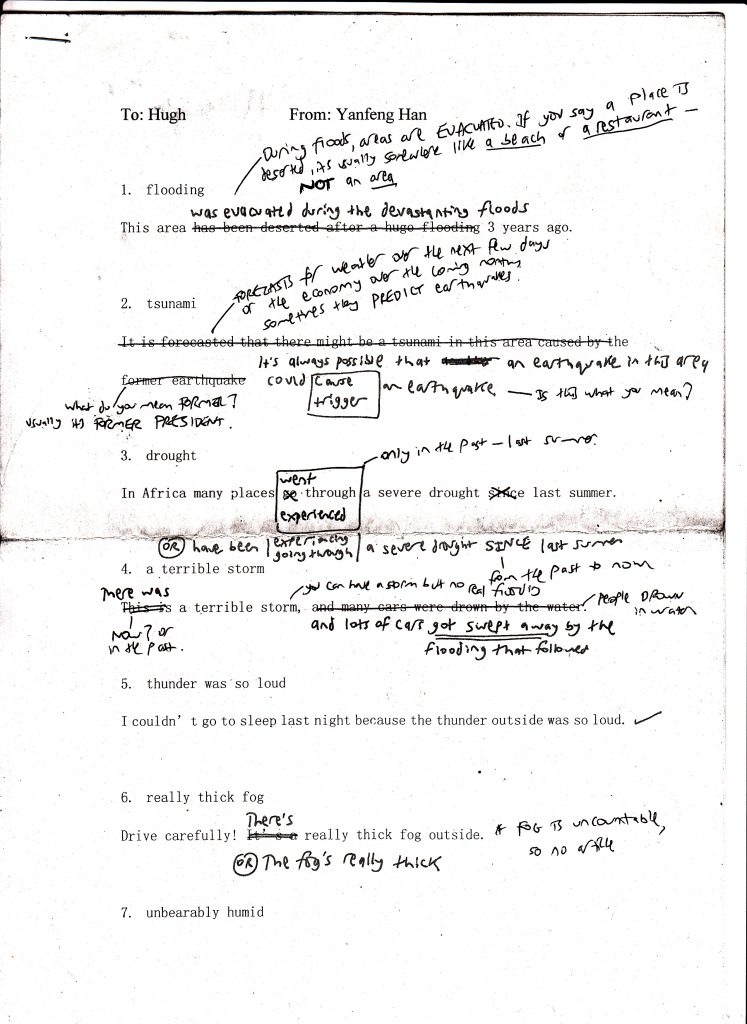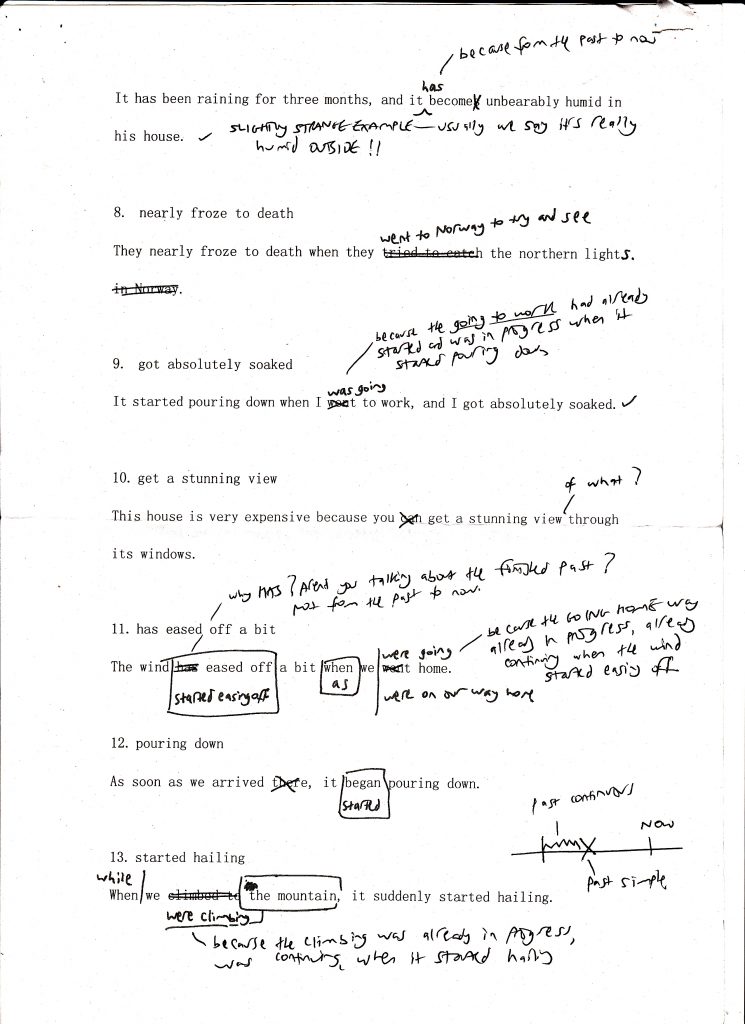Twenty Things in Twenty Years Part Nine: the vast majority of mistakes really aren’t to do with grammar!
The world used to be so tidy. Back in the misty morning of my youth, I seriously did naively believe that the root cause of student error was essentially grammatical. If only students could somehow have the ‘rules’ for the use of specific grammatical structures drilled into their heads through repeated mini-lectures, homeworks, pages of English Grammar in Use, concept questions and so on, and if only they could correctly memorise and internalise the forms of all the structures we’d ‘done’ in class, then all would be well, the occasional lexical slip notwithstanding.
It took me quite some time to realise that if the errors students are making are within the confines of tasks that only focus on and require the production of one or two grammatical structures, such as the old Harrap’s Communication Games classic Haven’t we met somewhere before? (wherein students got role-play cards detailing where they’d been at what times in their life and had to work out where and when exactly they’d met everyone else in the room, a task which inevitably forced errors along the lines of Yes, I’ve been in Australia in 1984), then the odds that these errors will essentially involve structural glitches are fairly high. The task creates and forces the mistakes it is designed to focus on. This is its purpose.
There may, of course, be a place for such a focus, though today I feel that the place really ought to be a far smaller one than that which I used to allow to exist. However, to extrapolate out from such experiences and to then believe that mistakes are mostly down to grammar is a fallacy of the highest order, albeit a fallacy I – and many many other teachers – have been suckered by, and that is still (implicitly, perhaps) propagated by The System.
If you want to become more aware of the real issues that students face when attempting to put their slow accumulation of knowledge into practice then a change of tack is needed – as is a focus on tasks which require the production of language outside the narrow confines of what are essentially grammar drills of varying kinds. Of course, one way of doing this is to listen to students as they speak and to pick up on things they struggle with or make mistakes with. This is all well and good and to be encouraged, I think, though I have a residual suspicion that what most teachers actually pick up during freer slots is grammar. This is what we’re most trained to focus on, and the way most of us are still trained to perceive errors, and old habits die hard. In addition, of course, in the flow and flux of everyday conversation, with maybe six or seven pairs of students all talking at once in class, it’s hard to notice much at all, let alone to notice it, think of decent ways of reformulating it, note this down somewhere or get it on the board somehow in a way that might later lead to you being able to do something interactive with it! No wonder we fall back into noticing what we’ve already been primed to notice. Even when we break through the filter of grammar and start seeing language in a broader sense, we all still come to the correction / recasting of student speech with our own schema, our own repertoires and bags of tricks that we know we can spin out into something of possible value, and all of this hampers us in our efforts to truly hear clearly and reformulate cogently and thoroughly.
Which brings us to an innovation I picked up from my co-author and colleague, Andrew Walkley. Many moons ago, we both taught at University of Westminster here in London and naturally, we both used the coursebooks we’ve co-authored, OUTCOMES. We started using Vocaroo to help students get to grips with the weight of new lexis they encountered in class. These were students studying fifteen hours a week, and at the end of every week we’d record fifty chunks / collocations onto Vocaroo and send the link to all the students. They’d then write them down as best they could, like a dictation; we’d send the original list and students would then write examples of how they think they might actually use each item – or hear each being used. These were emailed over and we’d correct them, comment on them, etc.
On one level, it was a very sobering experience because words that we felt we’d explained well, given extra examples of, nailed, as it were, would come back at us half digested, or garbled, or in utterly alien contexts with bizarre co-text. Of course, what’s really going on is the new language is somehow slowly getting welded awkwardly onto the old; meanings in the broadest sense are largely understood, but contexts of use not yet clearly grasped. Grammar mistakes of a far more complex and unwieldy kind than I’ve been to Australia in 1992 rear their ugly heads, mistakes far less amenable to communication games; meanings are expressed clumsily and yet more fluent ways of expressing them are elusive or many, making cogent feedback hard to frame in places.
This should not surprise, of course. The fact that students have encountered new items in class, seen them once or twice or even three times in some kind of context, possibly translated them and more or less grasped their meanings is simply evidence of the fact that they’ve not yet been primed anywhere near sufficiently. For fluent users who’ve grasped new items, there’s been encounter after encounter after encounter, with item and with co-text in context; for learners, this process has only just begun, and as a result the odds of priming from L1 being brought over when it comes to using the new items creatively is very high indeed.
It also tempers the expectation one should have of the power and value of correction. I’m under no illusion that the detailed comments and extensive correction / recasting I carry out on student efforts (see below) will somehow magically result in correct and fluent use henceforth. Rather, I see my work here simply as further efforts to prime and to draw attention to glitches, misconceptions, perennial misuses and so on; in short, I am merely a condensed and rather more focused part of the priming process.
What else you realise is the sheer futility of trying to explain much error through the filter of grammar. Take the first sentence shown below – The area has been deserted after a huge flooding 3 years ago. What’s a dogged grammar hound to do here? Point out that if we’re using AFTER when talking about something that happened three years ago, we’d generally use the past simple, so if we want to use the present perfect, it’d be better to use SINCE? If we’re talking about flooding, it’s usually uncountable and thus kill the A? Even if you were to do this, you’d still be left with: The area has been deserted since huge flooding three years ago, which still sounds very stilted and forced. Often, the only real solution to the morass of oddness these sentences throw one into is rather severe reworking, with options sometimes given, questions sometimes asked, and explanations often proffered.


Now, of course, you could very well argue that the task here has created the errors, and to a degree that’d obviously be true. However, the range of issues students have with each item varies immensely depending on L1, how much they read in English, what they’re actually trying to say and so on, so the range of problems is also massively expanded in comparison to what emerges from controlled grammar practice activities!
As well as casting a fairly glaring light onto the complexity of fluent language use and the long convoluted process of attempting to integrate the new with the old, it all also suggests that when we’re teaching new vocabulary, we need to pay more attention and thought to how well we’re priming students. The more we insist on – and write up – single ways or short ungrammaticalised chunks / collocations – the less chance our students have of really coming to terms with the ways in which new items are typically used with previously learned grammar and vocabulary, or the kinds of (often fairly limited) contexts in which items are used.
Any of you who ever have to deal with student writing as they prepare to do degrees or Master’s in English, where all the kinds of issues seen above are compounded with serious discoursal and structural issues, spelling problems, paragraphing anomalies, and so on will know what I mean when I claim that prevention is infinitely preferable to cure.
And that the medicine needed really isn’t all that much to do with grammar as we know it!
Want to learn more with Lexical Lab?
[…] Dellar’s latest blog post is Part Nine of his views on ELT. It’s called Part Nine: the vast majority of mistakes really aren’t to do with grammar! […]
Lately, I have been struggling with finding meaningful ways of correcting errors in recorded mini-dialogues of adult learners. Only yesterday, we were exploring the use of “on foot” and “by foot” and the difference between the two, if any. And the issue of whether it mattered at all when listening to fascinating accounts of getting to school 30-40 years ago in Italy, Brazil and Arkhangelsk in Russia. Luckily, our learners are not taking exams or writing MA’s, ‘only’ using English for communication. I still feel the need to offer better, more economical options in speaking and more intelligible versions in pronunciation. But I can feel the ground shifting under my feet and I’m often simply blown away by the stories. But, maybe, that’s the point? To be blown away by the beauty of the human mind when working with a second language and making a serious effort to express ourselves? Where does it leave me, the pedantic grammarian? In tears…